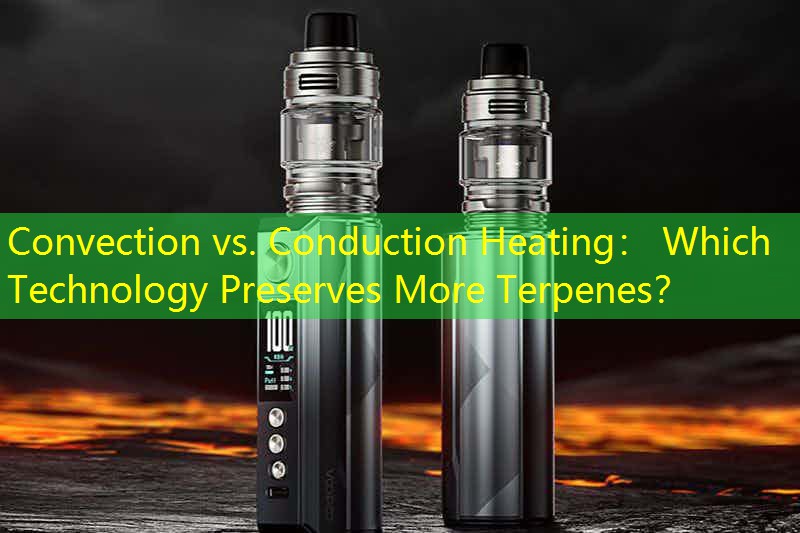Panimula
Ang mundo ng herbal vaporization ay malaki ang umusbong sa pagdating ng iba't ibang mga teknolohiya ng pag -init. Kabilang sa mga ito, Ang pag -init ng kombeksyon at pagpapadaloy ay nakakuha ng makabuluhang pansin, lalo na tungkol sa kanilang kakayahang mapanatili ang pinong mga compound ng lasa na kilala bilang terpenes. Ang artikulong ito ay magbibigay ng isang malalim na pagtingin sa convection vs. Mga Teknolohiya ng Pag -init ng Pag -init, Sinusuri ang kanilang mga katangian, Mga Karanasan sa Gumagamit, Competitive paghahambing, kalamangan at kahinaan, at target na mga demograpiko.
Ipinaliwanag ang mga teknolohiya ng pag -init
Pag -init ng kombeksyon
Ang pagpainit ng kombeksyon ay gumagamit ng mainit na hangin upang mapainit ang herbal na materyal, na nagpapahintulot sa kahit at tumpak na kontrol sa temperatura. Tinitiyak ng pamamaraang ito na ang mga aktibong compound, kabilang ang mga terpenes, ay singaw sa pinakamainam na temperatura nang walang pag -scorching ng materyal. Pinahahalagahan ng mga gumagamit ang kombeksyon para sa malinis at masarap na singaw, na maaaring mapanatili ang natatanging mga profile ng iba't ibang mga strain.
Pag -init ng pagpapadaloy
Sa kaibahan, Ang pag -init ng pagpapadaloy ay nakasalalay sa direktang pakikipag -ugnay sa pagitan ng elemento ng pag -init at ng herbal na materyal. Habang ang pamamaraang ito ay madalas na mas mabilis at maaaring magbigay ng isang matatag na karanasan sa singaw, Panganib ito sa sobrang pag -init, potensyal na nagpapabagal ng mga terpenes at iba pang pabagu -bago ng mga compound. Ang mga gumagamit sa pangkalahatan ay nakakahanap ng mga aparato ng pagpapadaloy upang maging mas diretso at madalas na mas mura, Ngunit maaari nilang isakripisyo ang integridad ng lasa para sa bilis.

Mga Tampok ng Produkto
Parehong mga vaporizer ng convection at conduction ay may iba't ibang mga tampok, kabilang ang control control, Portability, at buhay ng baterya. Ang mga aparato ng kombeksyon sa pangkalahatan ay nagtatampok ng mas advanced na teknolohiya na nagpapadali ng tumpak na pagsasaayos ng temperatura. Sa kaibahan, Ang mga modelo ng pagpapadaloy ay maaaring mag -alok ng pinasimple na mga interface, ginagawa silang mas madaling gamitin para sa mga kaswal na gumagamit.
Karanasan ng gumagamit
Ang karanasan ng gumagamit ay nag -iiba nang malaki sa pagitan ng dalawang teknolohiya. Ang pag -init ng kombeksyon ay madalas na nangangailangan ng isang curve ng pag -aaral upang makabisado ang perpektong mga setting ng draw at temperatura. Gayunpaman, Iniulat ng mga gumagamit na ang kabayaran ay mayaman, Mas maraming nakakainis na lasa. Kabaligtaran, Pinahahalagahan ng mga gumagamit ng pagpapadaloy ang kadalian ng paggamit ngunit maaaring mapansin ang mga nabawasan na profile ng lasa dahil sa hindi pantay na pag -init.
Competitive paghahambing
Sa mapagkumpitensyang tanawin, Ang mga tatak tulad ng bulkan at firefly ay humantong sa pag -init ng kombeksyon, habang ang PAX at G Pen Excel sa mga pagpipilian sa pagpapadaloy. Ang mga aparato ng kombeksyon ay karaniwang dumating sa isang mas mataas na punto ng presyo, sumasalamin sa kanilang higit na mahusay na mga kakayahan sa pagpapanatili ng lasa. Pa, Ang mga singaw ng conduction ay madalas na nag-apela sa mga mamimili na may kamalayan sa badyet na naghahanap ng pagiging simple at kaginhawaan.
Kalamangan at kahinaan
Convection Heating Pros
– Superior Terpene Preservation
– Kahit na ang pag -init
– Mas malalim na lalim ng lasa
Convection Heating Cons
– Mas mataas na gastos
– Mas kumplikado upang magamit
Pag -aalaga ng Pag -init ng Pag -init
– Mabilis na oras ng pag-init
– Friendly na gumagamit
– Sa pangkalahatan ay mas mura
Conduction Heating Cons
– Potensyal para sa hindi pantay na pag -init
– Panganib sa pagkasira ng lasa
Target na Pagtatasa ng Gumagamit
Ang mga target na demograpiko para sa mga vaporizer ng kombeksyon ay karaniwang kasama ang mga connoisseurs at nakikilala ang mga gumagamit na unahin ang lasa at kalidad. Ang mga taong ito ay madalas na handang mamuhunan nang higit pa sa isang premium na produkto. Sa kaibahan, Ang mga aparato ng pagpapadaloy ay may posibilidad na maakit ang mas maraming mga kaswal na gumagamit o bago sa herbal vaping, Habang nag -aalok sila ng isang naa -access na punto ng pagpasok nang hindi nangangailangan ng malawak na kaalaman tungkol sa control ng temperatura o mga diskarte sa singaw.

Konklusyon
Sa buod, Ang pagpili sa pagitan ng convection at conduction heating ay higit sa lahat ay nakasalalay sa mga indibidwal na kagustuhan at prayoridad. Ang kombeksyon ay nagbibigay ng isang mahusay na karanasan para sa mga naghahanap upang mapanatili ang mga terpenes at masiyahan sa mayaman na lasa, Habang ang pagpapadaloy ay nag -aalok ng pagiging simple at bilis para sa mga kaswal na gumagamit. Ang pag -unawa sa mga pagkakaiba na ito ay mahalaga para sa paggawa ng isang kaalamang desisyon sa pabago -bagong mundo ng herbal vaporization.







